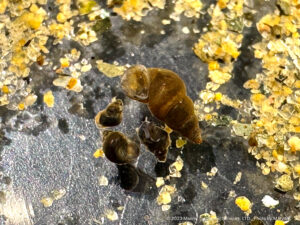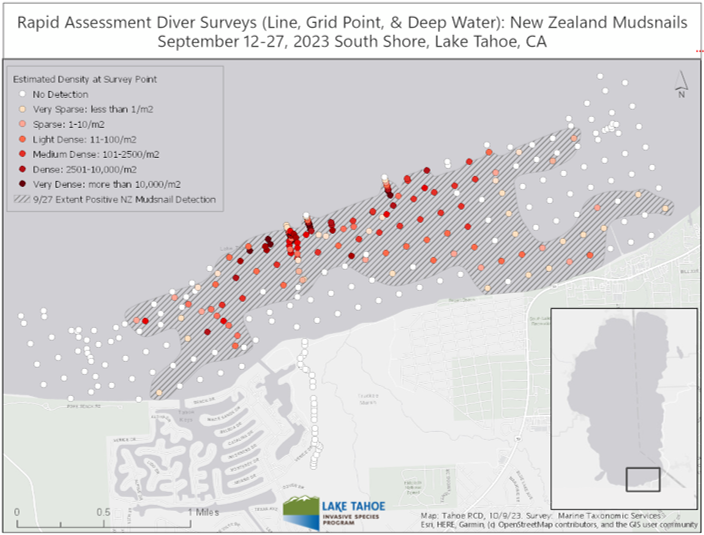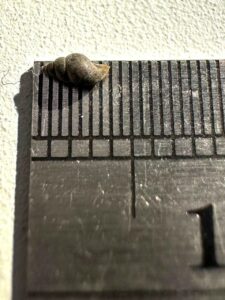New Zealand Mudsnail
Updated 10/19/2023
New Zealand mudsnails detected in Lake Tahoe
A new aquatic invasive species, New Zealand mudsnail, has been discovered in Lake Tahoe. This is the first time the species has been detected in the Tahoe Basin. This fact sheet explains what you need to know right now.

New Zealand mudsnails found in Lake Tahoe, shown with sand particles from the lake. Credit: Marine Taxonomic Services, Ltd.
Following rapid response protocols under the federally approved Lake Tahoe Aquatic Invasive Species Management Plan, an Incident Team has been established comprised of staff from the Tahoe Resource Conservation District (Tahoe RCD) and Tahoe Regional Planning Agency (TRPA).
How were they found?
The Lake Tahoe Aquatic Invasive Species Program includes comprehensive monitoring of Lake Tahoe for aquatic invaders. Contract divers with Marine Taxonomic Services, Ltd. surveying invasive weeds on the South Shore of Lake Tahoe discovered tiny snails on the bottom of the lake nearly a half mile offshore from the mouth of the Upper Truckee River. Consultation with experts and a DNA lab analysis confirmed the species is New Zealand mudsnail.
Why are New Zealand mudsnails a concern?
Aquatic invasive species are a national problem. When a non-native species is introduced into a waterbody, they can outcompete native species and impair natural habitats and water quality.
New Zealand mudsnails are an invasive species first discovered in North America in the Snake River, Idaho in 1987. They are now found in 22 states including California and Nevada and as close as the Lower Truckee River near Reno. Due to their hardiness, very small size, and ability to rapidly reproduce, they are able to colonize new waters quickly. New Zealand mudsnails are about the size of a grain of rice (2-6-mm).
How did they get into Lake Tahoe?
The Incident Team is in the information gathering stage. Because the snails are known to inhabit nearby waters, it is likely they were introduced from travel between them. Invasive species can be carried on boats, fishing gear, paddle craft, life vests, and beach toys, according to the national Stop Aquatic Hitchhikers! campaign.
How is the Lake Tahoe AIS Program Responding?
As of October 14, lake-wide surveys have not detected New Zealand mudsnails in other areas of the lake beyond where they were first seen. Further survey of area shows the invasive species has infested a 3-mile area of South Shore, shown on the map below. The density of mudsnails ranges across the infestation area, with up to 10,000 mudsnails per square meter measured in a few areas.

The Lake Tahoe Aquatic Invasive Species Program is calling upon its collaborative coordinating committee of scientists, wildlife biologists, non-profits, and resource managers to gather information and evaluate management options. The Lake Tahoe Science Advisory Council is engaged to ensure the best available science is used to inform management decisions.
The public has been alerted to the threat. Boat inspection program protocols and paddler resources have been updated with new recommendations and requirements to help stop the spread of New Zealand mudsnails to other lakes and other parts of Lake Tahoe.

A New Zealand mudsnail shell measuring 6 mm from the discovery in Lake Tahoe. Credit: Marine Taxonomic Services, Ltd.
What can I do?
It is critical for everyone to be vigilant about Clean, Drain, and Dry. Every boater, paddler, and angler shares the responsibility to protect the waters we enjoy from invasive species.
Anglers should avoid the use of felt bottomed boots and freeze or bleach any equipment used before going to other waters. Live bait is not allowed in the Tahoe Region and transportation of bait to and from Lake Tahoe should be avoided.
Please visit the following for more resources on how to Clean, Drain, and Dry motorized or non-motorized watercraft and equipment:
What is being done to protect Lake Tahoe?
Lake Tahoe is one of the most protected waterbodies in the United States and our aquatic invasive species monitoring program is credited as the reason for this concerning discovery.
TRPA advocated for federal funds to be set aside for early detection and rapid response actions throughout the nation. Tahoe agencies are using critical federal funds to address the New Zealand mudsnail introduction.
As climate change continues to affect Lake Tahoe’s native ecosystem, the threat of new invasive species taking hold in the region is increasing. Under the Lake Tahoe Environmental Improvement Program, the AIS Program is helping protect water quality and native species and is a key program to improve the climate resilience of the region.
